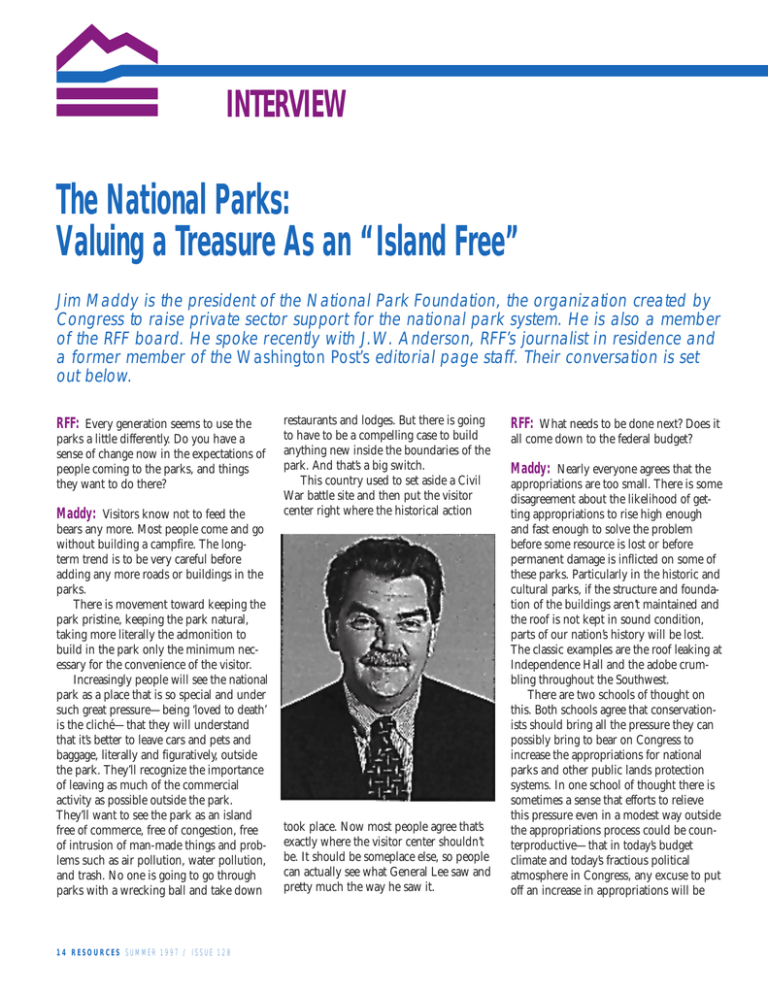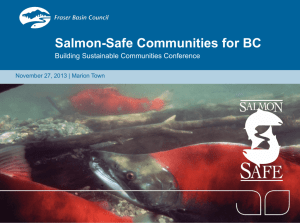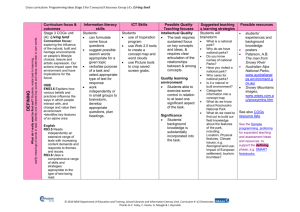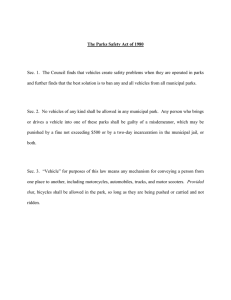The National Parks: Valuing a Treasure As an “Island Free”
advertisement

RESOURCES FOR THE FUTURE INTERVIEW The National Parks: Valuing a Treasure As an “Island Free” Jim Maddy is the president of the National Park Foundation, the organization created by Congress to raise private sector support for the national park system. He is also a member of the RFF board. He spoke recently with J.W. Anderson, RFF’s journalist in residence and a former member of the Washington Post’s editorial page staff. Their conversation is set out below. RFF: Every generation seems to use the Maddy: Visitors know not to feed the restaurants and lodges. But there is going to have to be a compelling case to build anything new inside the boundaries of the park. And that’s a big switch. This country used to set aside a Civil War battle site and then put the visitor center right where the historical action bears any more. Most people come and go without building a campfire. The longterm trend is to be very careful before adding any more roads or buildings in the parks. There is movement toward keeping the park pristine, keeping the park natural, taking more literally the admonition to build in the park only the minimum necessary for the convenience of the visitor. Increasingly people will see the national park as a place that is so special and under such great pressure—being ‘loved to death’ is the cliché—that they will understand that it’s better to leave cars and pets and baggage, literally and figuratively, outside the park. They’ll recognize the importance of leaving as much of the commercial activity as possible outside the park. They’ll want to see the park as an island free of commerce, free of congestion, free of intrusion of man-made things and problems such as air pollution, water pollution, and trash. No one is going to go through parks with a wrecking ball and take down took place. Now most people agree that’s exactly where the visitor center shouldn’t be. It should be someplace else, so people can actually see what General Lee saw and pretty much the way he saw it. parks a little differently. Do you have a sense of change now in the expectations of people coming to the parks, and things they want to do there? 14 RESOURCES SUMMER 1997 / ISSUE 128 RFF: What needs to be done next? Does it all come down to the federal budget? Maddy: Nearly everyone agrees that the appropriations are too small. There is some disagreement about the likelihood of getting appropriations to rise high enough and fast enough to solve the problem before some resource is lost or before permanent damage is inflicted on some of these parks. Particularly in the historic and cultural parks, if the structure and foundation of the buildings aren’t maintained and the roof is not kept in sound condition, parts of our nation’s history will be lost. The classic examples are the roof leaking at Independence Hall and the adobe crumbling throughout the Southwest. There are two schools of thought on this. Both schools agree that conservationists should bring all the pressure they can possibly bring to bear on Congress to increase the appropriations for national parks and other public lands protection systems. In one school of thought there is sometimes a sense that efforts to relieve this pressure even in a modest way outside the appropriations process could be counterproductive—that in today’s budget climate and today’s fractious political atmosphere in Congress, any excuse to put off an increase in appropriations will be INTERVIEW closest competitors, it was very generously providing support for the national parks. I would like to test the value of that. I would like to know what it is worth to one firm in each of several separate business sectors to have “bragging rights” about being a substantial financial contributor to the parks. My guess is that somewhere between $80 million and $100 million a year could be generated for many, many years. I think it is worth a try. seized upon by people in both parties. The second school of thought says yes, there’s not enough money there. It would be very desirable to have the increased appropriations and from time to time some increase can be achieved. But this second school of thought (and that’s where I would put myself and certainly the National Park Foundation) believes that we’re going to have to invent new ways to supplement appropriated funds. If we really do expect not only to keep the parks from deteriorating, but also to expand and improve national parks, we are going to have to reach out to private funds, somehow find some ways private sources of funding can supplement appropriated funds. The purpose of that support is not only to save the resource or try to catch up with some of the deferred maintenance, but also to extract the full measure of value from the parks that’s there for the benefit of the public. And here I am thinking about education programs for people of all ages, and life-changing opportunities to bring young people into national parks in a way that could have a big, bold, measurable impact on their lives at a crucial time. There is unlimited, just unlimited, potential for national parks to improve the education that we get as Americans, to improve the quality of our lives. But it costs money to get to that value. Congress is struggling to fully fund the maintenance and protection of national parks. Private sources are the best hope to fund expanded education programs based on park resources. If the public and Congress had a better idea of just how many trillions of dollars this asset represents on the national balance sheet, they might be more likely to adequately fund park maintenance. RFF: You had legislation in the last RFF: What can economics do for the Congress? parks? Maddy: The National Park Foundation Maddy: One very straightforward thing supported legislation in the last Congress that would have made it possible to find out what it is worth to a company to be able to advertise the fact that, unlike its that economic analysis could do for the parks would be to assign a value to them. Surely, it is true that you can’t measure the full value of national parks in dollars. I’ll What happened to this legislation last year is that quite a number of organizations that are strong defenders of the environment and strong defenders of national parks, organizations that the National Park Foundation certainly considers allies, objected to some of the specific language in the legislation. We need to see if these things can be worked out before another bill is taken to the Hill. I would say it is more important to get it right than to get it fast. If it takes us a couple of more years to get it right, I think it will be well worth it. stipulate that, but I do believe it is possible to make a meaningful estimate of their economic value. It would only be some small fraction of their total value to the country and to the society, but even the small fraction of the value that could be reduced to dollars, I suspect, is a very impressive number. Sometimes I think if the public and if members of Congress had a better idea of just how many trillions of dollars this asset represents on the national balance sheet, they might be more likely to adequately fund park maintenance. One of the things the Park Service itself has identified to which RFF could contribute enormously is improving the ability of all of us to understand the national parks as central features of regional economies. Every once in a while, through inadvertence, there is a chance to do a controlled experiment. A park will close because of a natural disaster, as happened this winter in Yosemite with the flooding. There is an opportunity right now to think of this as a laboratory for economists. What impact does it have on tax receipts of local governments and on local economies? There’s something magical about national parks. Put that brown sign out on the interstate or put that special little marker on the fine print of a highway map and hundreds of thousands of people will go to that spot and look around to see what’s there. When they see the words “national park” on a highway marker they’ll change their plans. They’ll do whatever it takes to get there because the title “national park” conveys a guarantee of quality and value. SUMMER 1997 / ISSUE 128 RESOURCES 15






